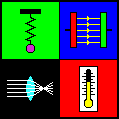
(Overview)
|
The top of a spring pendulum (red circle) is moved to and fro - for example by hand; this motion is assumed as harmonic, which means that it is possible to describe the motion by a cosine function. The oscillations of the spring pendulum caused in this way are called forced oscillations.
The "Reset" button brings the spring pendulum to its initial position. You can start or stop and continue the simulation with the other two buttons. If you choose the option "Slow motion", the movement will be five times slower. The spring constant, the mass, the constant of attenuation and the angular frequency of the exciting oscillation can be changed within certain limits. In addition you can select one of three diagrams by using the appropriate radio buttons:
On the whole you can see three different types of behaviour:
If the exciter's frequency is very small (this means that the top of the spring pendulum is moved very slowly), the pendulum will oscillate nearly synchronously with the exciter and nearly with the same amplitude.
If the exciter's frequency agrees with the characteristic frequency of the spring pendulum, the oscillations of the pendulum will build up more and more (resonance); in this case the oscillations are delayed about one fourth of the oscillation period compared with the exciter.
If the exciter's frequency is very high, the resonator will oscillate only with a very small amplitude and nearly the opposite phase.
If the constant of attenuation (the friction) is very small, the transient states will be important too; therefore you have to wait some time in this case to notice the mentioned types of behaviour.
This applet is based on formulas which look rather complicate. If you don't like mathematics, you should click here under no circumstances.
 |
| Physics Applets (Overview) |
URL: http://www.walter-fendt.de/ph11e/resonance.htm
© Walter Fendt, September 9, 1998
Last modification: December 27, 2002